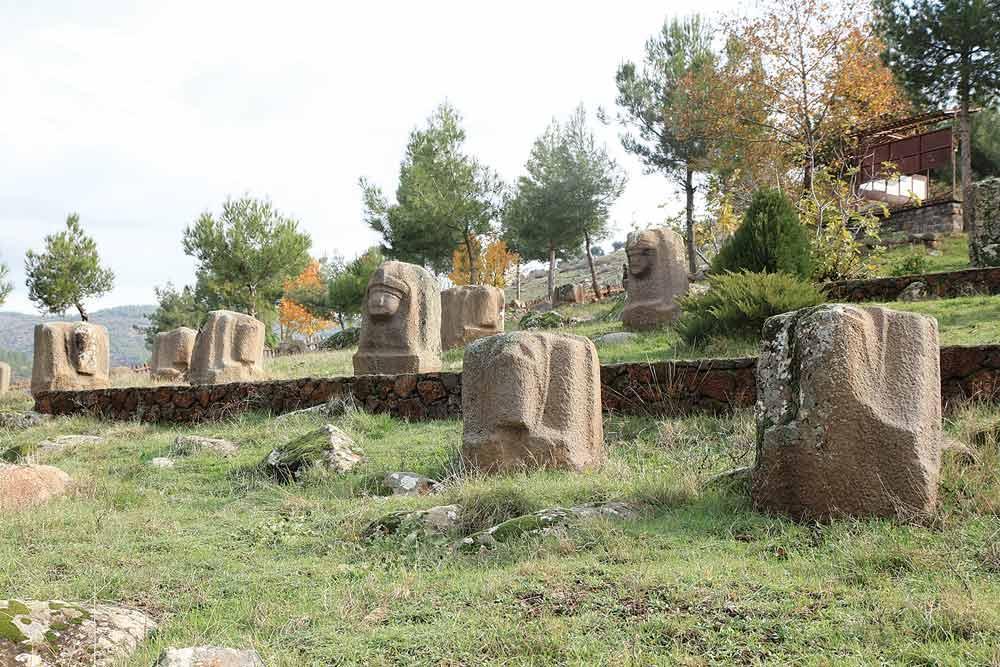
Turkey’s southeastern province of Gaziantep is home to one of the world’s most enigmatic and fascinating archeological sites in the world. We are not talking about Zeugma and its celebrated mosaics, but the Yesemek sculpture workshop, which lies on the hills of Karatepe about 113 km from the city center in the İslahiye district.
Around 300 sculptures weighing between 500 kg and 15 tons lay scattered on the landscape, with semi-finished sculptures of imposing lions, sphinxes, and mountain gods, dating back to the late Hittite period between 1000-900 B.C.
The sculptures are thought to have been used in the monuments of the Samal Kingdom capital, located in today’s Zincirli Mound, which is another important archeological site nearby.
Years of archeological research have revealed the story of labor on the basaltic material found on Karatepe. After the blocks were cut from the main rocks of basalt, craftsmen at the workshop would prepare the first rough drafts of the sculptures and carve the main features of the figures. In the following stage, the heavy sculptures would be sent to their destination and their final details would be carved there according to the commission. The lion’s mouth, tongue, details in the sphinx’s hair and the ornaments would then appear.
The logistics of how blocks weighing up to 15 tons were sent to nearby cities are still debated, but it is worth noting that the area was surrounded by lakes and water flows, essential natural transport infrastructures of the ancient world. After the Assyrian invasion of the eighth century B.C., production abruptly came to an end and the workshop was closed.
Today, work is underway to establish the site’s “outstanding universal value” in order to have it listed as a UNESCO World Heritage Site.
The site has been on the tentative list since 2012. Under the leadership of the Gaziantep Metropolitan Mayor Fatma Şahin, the process has started in collaboration with the Ministry of Culture and Tourism. Last week between Nov. 7 and 9, it reached a crucial step as the municipality hosted a symposium gathering more than 50 Turkish and international experts from different fields ranging from archeology, history, mineralogy, petrology and the protection of cultural heritage.
For the first time, a multidisciplinary group of Turkish and foreign experts had the chance to share their insights about the area and its geology, as well as of other related sites in the region, going all the way to a now devastated Aleppo.
After a one-day long field trip, the symposium was opened on the premises of the Gaziantep University by Professor Refik Duru, the doyen of Turkish Archeology, who exposed the historical perspective and importance of the archeological excavations in Gaziantep.
In fact, Zincirli, the capital of the Samal kingdom and the recipient of the Yesemek sculptures, was the first scientific excavation of Anatolia, performed between 1888 and 1902 by Felix von Luschan. Later in 1955, Refik Duru was just an archeology student when he and his professor Bahadır Alkım set out to investigate the İslahiye plain. Deciding to trace a very vague reference to “Gesemek” made previously by von Luschan, they embarked on a difficult trip in a World War II jeep through desolate and dusty lands, and with the help of locals they were finally able to locate Yesemek and start archeological excavations of the site. The excavations finished in 1961, after which the site was turned into an open air museum.
The two-day symposium exposed the deep connection between geography and human intervention throughout centuries, resulting in a unique cultural landscape that tells the story of a mass production process, the artistic expression of that era’s beliefs and aspirations, as well as the untold story of the quarryman and the craftsman. It is a fabric that needs to be preserved and managed with a holistic approach, requiring the coordination of various public and private entities and all local stakeholders, especially the community living in the Yesemek village.
The municipality of Gaziantep is no stranger to leading such complex processes. In fact, it has established itself as an international benchmark after completing an ambitious urban regeneration program that rehabilitated the historic town and boosted its local economic development.
Candidates for the UNESCO World Heritage List must also prepare a management plan that will formulate the balance between conservation and sustainable utilization of the site. Once these principles are established, the touristic attractiveness of the whole region will hopefully bounce back, as the conflict in neighboring Syria comes to an end, and our common heritage becomes the basis for regional development.